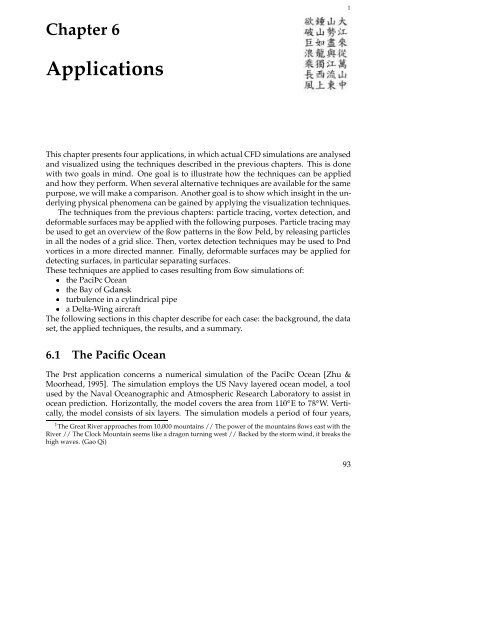Chapter 4 Vortex detection - Computer Graphics and Visualization
Chapter 4 Vortex detection - Computer Graphics and Visualization
Chapter 4 Vortex detection - Computer Graphics and Visualization
You also want an ePaper? Increase the reach of your titles
YUMPU automatically turns print PDFs into web optimized ePapers that Google loves.
<strong>Chapter</strong> 6<br />
Applications<br />
This chapter presents four applications, in which actual CFD simulations are analysed<br />
<strong>and</strong> visualized using the techniques described in the previous chapters. This is done<br />
with two goals in mind. One goal is to illustrate how the techniques can be applied<br />
<strong>and</strong> how they perform. When several alternative techniques are available for the same<br />
purpose, we will make a comparison. Another goal is to show which insight in the underlying<br />
physical phenomena can be gained by applying the visualization techniques.<br />
The techniques from the previous chapters: particle tracing, vortex <strong>detection</strong>, <strong>and</strong><br />
deformable surfaces may be applied with the following purposes. Particle tracing may<br />
be used to get an overview of the ßow patterns in the ßow Þeld, by releasing particles<br />
in all the nodes of a grid slice. Then, vortex <strong>detection</strong> techniques may be used to Þnd<br />
vortices in a more directed manner. Finally, deformable surfaces may be applied for<br />
detecting surfaces, in particular separating surfaces.<br />
These techniques are applied to cases resulting from ßow simulations of:<br />
¯ the PaciÞc Ocean<br />
¯ the Bay of Gda«nsk<br />
¯ turbulence in a cylindrical pipe<br />
¯ a Delta-Wing aircraft<br />
The following sections in this chapter describe for each case: the background, the data<br />
set, the applied techniques, the results, <strong>and</strong> a summary.<br />
6.1 The Pacific Ocean<br />
The Þrst application concerns a numerical simulation of the PaciÞc Ocean [Zhu &<br />
Moorhead, 1995]. The simulation employs the US Navy layered ocean model, a tool<br />
used by the Naval Oceanographic <strong>and</strong> Atmospheric Research Laboratory to assist in<br />
Æ Æ ocean prediction. Horizontally, the model covers the area from Eto W. Vertically,<br />
the model consists of six layers. The simulation models a period of four years,<br />
1 The Great River approaches from 10,000 mountains // The power of the mountains ßows east with the<br />
River // The Clock Mountain seems like a dragon turning west // Backed by the storm wind, it breaks the<br />
high waves. (Gao Qi)<br />
1<br />
93

















